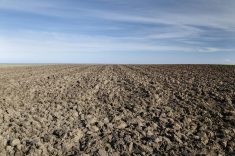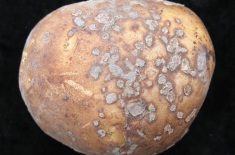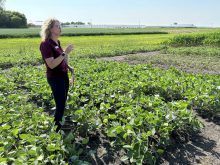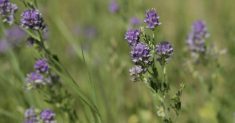Which one will soak it up first?
That was the question a recent demonstration at the Manitoba Beef and Forage Initiatives (MBFI) Brookdale site tried to answer. It was a head-to-head comparison of the ability of fields to soak up surface moisture by Mitchell Timmerman, the province’s agri-ecosystems specialist, using a rainfall simulator that made the comparison before the eyes of attendees.
The simulation mimics a major weather event, with water flows upwards of six to 10 inches per hour. Run-off was collected for each sample and compared to the volume of water that soaked through to the bottom of the simulator, indicating moisture that would have seeped into the earth in the field.
Read Also

Manitoba sclerotinia picture mixed for 2025
Variations in weather and crop development in this year’s Manitoba canola fields make blanket sclerotinia outlooks hard to pin down
Hydraulics controlled each sample’s slope, allowing presenters to mimic a field’s landscape or highlight the effect to topography during educational events like the MBFI field tour.
“What I’m illustrating here is how landscape and soil type and annual versus perennial (crops) can influence how much water management farmers can achieve, as well as (how) the activity of the animals on the surface can come into play,” Timmerman said. “It’s about integrating those factors together to come up with a site-specific strategy for a farmer to get the most out of the water resources that are available, whether they’re too plentiful or in short supply, and building adaptability or a better buffer into the system.”
Samples for the test were largely drawn from the same land that was on tour.

Clay loam was taken from MBFI Brookdale’s annual forage stand, mob grazing experiment and continuous grazing pasture. Those samples were compared to clay loam lying fallow near Roblin, as well as the sandier soils and perennial grassland of MBFI’s First Street pasture.
The First Street pasture sample soaked up more water, something Timmerman said was no surprise given its coarser texture. Between clay loam samples, both mob and continuously grazed fields pulled ahead of annual forage in the simulation, although Timmerman noted that the annual forage sample, grown on the former zero-till research farm that now houses MBFI, still soaked up the majority of water it was exposed to.
The summerfallow sample was the only one where run-off volumes outweighed infiltration.
“Considering how this growing season’s gone compared to last year, farmers are interested both in now too much moisture and not enough,” Timmerman said. “The beauty of perennial crops is that they offer advantages of both improving soil to drain away excess water but also to tap into water resources when water supplies are down.”
In many ways, Timmerman said, perennial crops can be seen as a natural version of tile drainage.
Under tile drainage, piping is buried in a grid to draw excess moisture deeper and drain it out of the field while gates may control flows and water table levels, something advocates have argued can protect against drought.
Organizations such as the Manitoba Forage and Grassland Association argue that perennial root systems help break up compaction, allowing for more infiltration, while deeper roots can access deeper subsoil moisture during dry periods.
Research presented by Manitoba Agriculture has found much deeper roots in perennial crops. In mapping root traits between annual crops and perennial forages, the province noted that alfalfa roots could reach up to 20 feet deep, compared to four feet in spring wheat or corn.
A 2011 study by Alberta Agriculture found that alfalfa used between 540-680 millimetres of water over three cuts in comparison to wheat’s 420-480 millimetres. Corn used 580-650 millimetres of water, although both corn and wheat peaked water usage in mid- to late summer, while alfalfa peaked prior to each of the three cuts.
Alfalfa rated 22-24 inches of water uptake over a season, compared to 12-16 inches in wheat and 20-24 inches for corn, according to data presented by Timmerman.




















